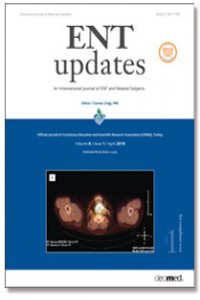Öz
Objective: This study aims to investigate
the novel use of a simple and inexpensive bipolar-assisted tonsil
reduction (B-TR) technique in pediatric cases with adenotonsillar
hyperplasia by evaluating long-term results, possible complications,
need for reoperation and incidence of recurrence.
Methods: We
present our long-term retrospective data from 78 consecutive pediatric
cases undergoing B-TR combined with adenoidectomy from April 2013 to
January 2017. The tonsillar sizes were recorded using the Brodsky
grading scale from I to IV, and the patients only with prominant
tonsillar sizes (III and higher) and adenoidal sizes exceeding 50% were
included in the study group. The tonsil sizes were noted preoperatively,
and during the latest follow-up visit after tonsillotomy (min. 9 months
postoperatively).
Results:
With a mean follow-up period of 18.3 months, the mean tonsillar size
preoperatively was 3.47 (±0.50) and mean tonsillar size postoperatively
was 1.35 (±0.48). A significant difference (p<0.001) was observed
between these two groups, excluding the only case who later had
undergone tonsillectomy. Minimal uvular edema was noted in 27 children
(34.6%), which did not cause any upper airway obstruction in these
patients.
Conclusion: We
describe herein our B-TR technique in details so that it can be learned
relatively quickly and used in pediatric cases with adenotonsillar
hyperplasia as a treatment option.
Anahtar Kelimeler
Tonsillotomy tonsillectomy bipolar diathermy tonsil reduction
Kaynakça
- 1. Darrow DH, Siemens CI. Indications for tonsillectomy and ade- noidectomy. Laryngoscope 2002;112(8 Pt 2 Suppl 100):6–10. 2. Hoey AW, Foden NM, Hadjisymeou Andreou S, et al. Coblation ® intracapsular tonsillectomy (tonsillotomy) in children: a prospec- tive study of 500 consecutive cases with long-term follow-up. Clin Otolaryngol 2017;42:1211–7. 3. Isaacson G. Pediatric intracapsular tonsillectomy with bipolar elec- trosurgical scissors. Ear Nose Throat J 2004;83:702, 704–6. 4. Shaul C, Attal PD, Schwarz Y, et al. Bipolar tonsillotomy: a novel and effective tonsillotomy technique. Int J Pediatr Otorhinolaryngol 2016;84:1–5. 5. Stelter K, Ihrler S, Siedek V, Patscheider M, Braun T, Ledderose G. 1-year follow-up after radiofrequency tonsillotomy and laser tonsillotomy in children: a prospective, double-blind, clinical study. Eur Arch Otorhinolaryngol 2012;269:679–84. 6. Hultcrantz E, Ericsson E, Hemlin C, et al. Paradigm shift in Sweden from tonsillectomy to tonsillotomy for children with upper airway obstructive symptoms due to tonsillar hypertrophy. Eur Arch Otorhinolaryngol 2013;270:2531–6. 7. Fischer M, Horn IS, Quante M, et al. Respiratory complications after diode-laser-assisted tonsillotomy. Eur Arch Otorhinolaryngol 2014;271:2317–24. 8. Sunnergren O, Hemlin C, Ericsson E, et al. Radiofrequency tonsil- lotomy in Sweden 2009–2012. Eur Arch Otorhinolaryngol 2014; 271:1823–7. 9. Vogt K, Konuhova S, Peksis K, Markow J. Development and clinical evaluation of bipolar radiofrequency cryptolysis. Otorhinolaryngology - Head and Neck Surgery 2016;2:1–5. 10. Taneja M, Taneja MK. Intra turbinate diathermy cautery V/S high frequency in inferior turbinate hypertrophy. Indian J Otolaryngol Head Neck Surg 2010;62:317–21.
Öz
Kaynakça
- 1. Darrow DH, Siemens CI. Indications for tonsillectomy and ade- noidectomy. Laryngoscope 2002;112(8 Pt 2 Suppl 100):6–10. 2. Hoey AW, Foden NM, Hadjisymeou Andreou S, et al. Coblation ® intracapsular tonsillectomy (tonsillotomy) in children: a prospec- tive study of 500 consecutive cases with long-term follow-up. Clin Otolaryngol 2017;42:1211–7. 3. Isaacson G. Pediatric intracapsular tonsillectomy with bipolar elec- trosurgical scissors. Ear Nose Throat J 2004;83:702, 704–6. 4. Shaul C, Attal PD, Schwarz Y, et al. Bipolar tonsillotomy: a novel and effective tonsillotomy technique. Int J Pediatr Otorhinolaryngol 2016;84:1–5. 5. Stelter K, Ihrler S, Siedek V, Patscheider M, Braun T, Ledderose G. 1-year follow-up after radiofrequency tonsillotomy and laser tonsillotomy in children: a prospective, double-blind, clinical study. Eur Arch Otorhinolaryngol 2012;269:679–84. 6. Hultcrantz E, Ericsson E, Hemlin C, et al. Paradigm shift in Sweden from tonsillectomy to tonsillotomy for children with upper airway obstructive symptoms due to tonsillar hypertrophy. Eur Arch Otorhinolaryngol 2013;270:2531–6. 7. Fischer M, Horn IS, Quante M, et al. Respiratory complications after diode-laser-assisted tonsillotomy. Eur Arch Otorhinolaryngol 2014;271:2317–24. 8. Sunnergren O, Hemlin C, Ericsson E, et al. Radiofrequency tonsil- lotomy in Sweden 2009–2012. Eur Arch Otorhinolaryngol 2014; 271:1823–7. 9. Vogt K, Konuhova S, Peksis K, Markow J. Development and clinical evaluation of bipolar radiofrequency cryptolysis. Otorhinolaryngology - Head and Neck Surgery 2016;2:1–5. 10. Taneja M, Taneja MK. Intra turbinate diathermy cautery V/S high frequency in inferior turbinate hypertrophy. Indian J Otolaryngol Head Neck Surg 2010;62:317–21.
Ayrıntılar
| Birincil Dil | İngilizce |
|---|---|
| Konular | Sağlık Kurumları Yönetimi |
| Bölüm | Makaleler |
| Yazarlar | |
| Yayımlanma Tarihi | 5 Nisan 2018 |
| Gönderilme Tarihi | 17 Şubat 2018 |
| Yayımlandığı Sayı | Yıl 2018 Cilt: 8 Sayı: 1 |

